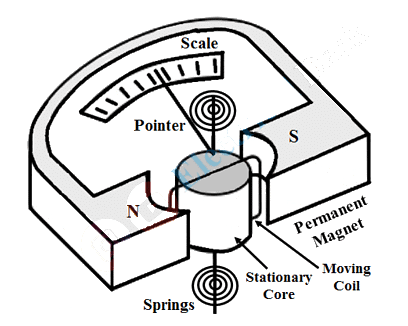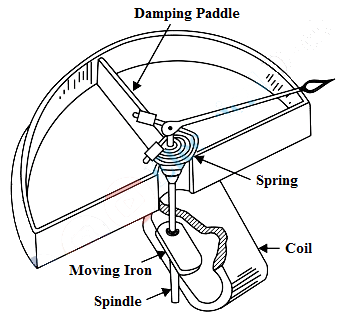Detailed Notes: Digital Voltmeter (DVM) | GATE Notes & Videos for Electrical Engineering - Electrical Engineering (EE) PDF Download
Errors in Moving Coil (PMMC) Instruments
The most common errors in moving coil instruments are due to,
- Ageing of permanent magnets,
- Ageing of springs, and
- Temperature variations.

Errors due to Ageing of Permanent Magnets
Due to the use of permanent magnets, the ageing of magnets causes its weakening, thereby resulting in a reduced magnetic field. The decrease in the magnetic field reduces the deflection torque that has to be produced. Therefore, the pointer deflection decreases and the reading obtained will be lesser than the actual value.
Errors due to Ageing of Springs
- Similar to the ageing of magnets, the ageing of springs causes an error in the readings obtained. Due to aging, the spring losses its ability to tolerate considerable bending or twisting. Due to which the control torque produced on the pointer decreases and the pointer deflects more than actual.
- Here we can see that the effects due to the ageing of magnets and springs are opposite to each other. Because the error introduced due to magnets ageing causes the reading obtained to be lesser than the actual value, whereas ageing of springs causes the reading obtained to be more than the actual value.
Errors due to Temperature Variations
- The variations in surrounding temperature can also introduce errors in moving coil instruments. There are two effects due to temperature variation, it affects the stiffness of the spring and flux density in the air gap. But these effects are in such a way that they will cancel each other resulting in not much error in the readings obtained.
- Due to variations in temperature, the resistance of the conductor used for moving coil varies, thereby changing the amount of current flowing through the coil that effects the deflection of pointer. For example, the temperature coefficient of copper is 0.004/°C i.e., the deflection of the instrument is reduced by 0.04% per °C rise in temperature.
Compensation of the Errors in PMMC Instruments
- The permanent magnets are treated by heat and vibrations resulting in loss of some magnetic properties but the remaining magnetic properties are strongly held. So, the ageing effect will not appear in the future.
- The effects due to ageing of springs can be reduced by careful use of materials and extending the life span during manufacturing.
- By using a series resistance made of materials having a negligible coefficient of temperature (like manganin) with the moving coil voltmeter reduces the effects due to temperature changes. The resistance of the series resistor or swamping resistor should be relatively higher than that of the moving coil.
Errors in Moving Iron Instruments
The errors in moving iron instruments are,
- Hysteresis error
- Temperature error
- Errors due to stray magnetic fields
- Errors due to change in frequency

Hysteresis Error
The main source of this error is the tendency of the iron parts in the instrument to store magnetism for short periods. Due to this error, for decaying values of currents, the flux appears to be more than its corresponding value. As the deflecting torque is directly proportional to the flux, the meter reads high.
Methods adopted to reduce this error are,
- Reducing the size of the iron part in the instrument.
- Reducing the value of operating flux density.
- Replacing the active iron part with nickel-iron alloy as it has a narrow hysteresis loop. With this method, the hysteresis error can be reduced to a large extent.
Temperature Error
The main source of this error is the temperature coefficient of the springs (for spring controlled instruments only), moving coil, and series resistance. Due to an increase in temperature, the overall resistance of the meter increases and so the current through the meter gets reduced. Hence. the meter reads low.
In order to reduce this error, the series resistance being employed is made with the material having a negligible temperature coefficient (like manganin, constantan, etc). The value of series resistance should be comparatively much higher than that of moving coil and springs.
Errors due to Stray Magnetic Fields
The main source of this error is the external magnetic fields which are stronger than the operating field. If the stray magnetic field aids the operating field, then the meter reads high and when it opposes, the meter reads low.
To reduce this error, magnetic shielding is provided by an iron case covering the instruments working parts.
Errors due to Change in Frequency
The main sources of this error are,
- Change in Reactance of the Meter Coil with Frequency - It is due to the dependence of the inductive reactance on the frequency of the supply i.e., the inductive reactance of the coil increases with an increase in frequency (XL = 2πfL). Hence, overall impedance also increases and so the current through the meter reduces. Hence, the deflection will be less. In order to neutralize this error in the case of MI voltmeters, a properly designed capacitor is connected across the series resistor (i.e., multiplier).
- Variations in the Eddy Currents with Frequency - The main source of this error is inducing eddy currents in the iron parts of instruments. The flux produced due to the flow of eddy currents opposes the main field (operating flux), according to Lenz's law. Hence, the meter reads low. The amount of reduction in flux varies with frequency. At lower frequencies, the reduction in flux is directly proportional to the square of the frequency, while at higher frequencies, it is almost constant. The only remedy to minimize this error is to reduce the iron parts in the vicinity of operating flux.
|
27 videos|333 docs
|















